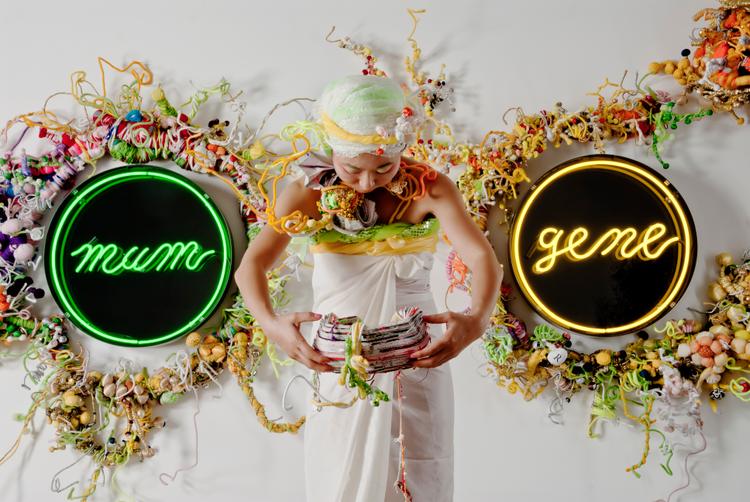First published in Daily Life, November 2014.
Australian art history has an alarming tendency to conflate notoriety and originality. The shiny allure that inspires cult biographies and mass hysteria among collectors, like in the case of Adam Cullen or Brett Whitely, isn’t just down to talent – it’s also about the ways in which the figure of the self-destructive artist squares up with a white, male tradition.
It’s a good thing that tradition has never been the best recipe for potential greatness. With practices that span everything from painting, sculpture and portraiture to installation, collage and assemblage, these five young female artists are expanding the possibilities of their respective mediums and rewriting dated art-world myths in the process.
Emily Hunt
Gnarled faces. Dismembered limbs. Creepy grins. If Emily Hunt’s intricate sculptures, wrought in glazed porcelain and stoneware, feel like dispatches from the kiln of a deranged potter, it’s because she believes that dread isn’t the stuff of nightmare but the natural consequence of our cultural moment. For the Sydney-based artist, who’s completed several residencies in Berlin and whose pieces appear as part of the MCA’s Primavera exhibition this year, carvings and artworks from the Middle Ages inform her intriguing take on modern-day vice and darkness. “I look back to the historical period between 1490 and 1550 A.D. because during this time grotesque caricature and woodcuts were totally gnarly and rude,” explains Hunt, who’s also inspired by sci-fi, drinking, long conversations and hard work. “Humans are pathetic and my work is motivated by the desire to cultivate a mode of catharsis by forcing viewers to grapple with the vulgar, the profane and the intemperate.”
Hiromi Tango
Hiromi Tango – quite literally – weaves art out of emotion. Five years ago, Tango, who relocated from regional Japan to Australia at 21, suffered a series of blows: a bout of post-natal depression sparked by the birth of her daughter Kimiyo, carpel tunnel syndrome caused by the demands of her practice and a mental state that saw friendships fall by the wayside. Dust Storm (2014), an installation that blends diary entries, tangled fabric forms and neon with photographs taken during Queensland’s 2009 dust storm, represents Tango’s attempt to work through this trauma and her belief that art can help you come to terms with the past. But Tango’s colourful pieces, which resemble flotsam washed up from an imaginary ocean, aren’t just avenues for her own healing – they’re also designed to help viewers make peace with long-buried pain. “When I make sculptures, I aim to engage all the senses and ask for fabric donations, diaries and letters that contain intense memories,” says Tango, who is also involved in a community arts project that sees her help people with disability and mental illness in Western Australia. “I am interested in the connections between the arts, science and mental health – and the process and power of listening.”
hiromitango.com
Textaqueen
Arlene Textaqueen has lofty ambitions for the humble texta. Fifteen years ago, the Perth-born artist used the felt-tip marker – a relic from primary-school drawing frenzies – to create playful alternatives to the salon nudes that hang in fabled art institutions. “I fell into drawing nude portraits serendipitously when asked to come up with content for a pay-per-view illustrated nude website,” says Textaqueen, whose work is held at the National Portrait Gallery, National Gallery of Victoria, Artbank and private collections across the UK and USA. “It prompted me to start on a twelve year series of ‘Textanudes’ where I asked women to pose naked in their bedrooms in props and poses of their choosing. When Textaqueen isn’t putting a pin in the male gaze, she’s using portraits to take on identity and race – her latest solo show Coconut Legacy used tigers, coconuts and Allen’s chocolate chico babies to map the conflict between white supremacy and her Goan-Indian heritage.
textaqueen.com
Sarah Contos
There’s something satisfying about seeing touchstones of Australian masculinity receive a feminine makeover. For Never-Never Land, a recent group show at Sydney’s Roslyn Oxley Gallery, artist Sarah Contos transformed images of Holden muscle cars, ripped from old issues of Australasian Post magazine, by printing them on sparkly, quilted fabric – the latest phase in a series of work that has seen her recast moulds of Shakespeare and Beethoven with fluro paint and embroider sequined masks on old Kamahl and Olivia Newton-John album covers. Contos, who blurs the line between painting, sculpture, textile and collage, says that taking part in this year’s Future Primitive exhibition at Melbourne’s Heide Museum of Modern Art has been her defining moment so far. “I like to make installations that explore identity, myth and memory and use elements from popular culture to mix the familiar and uncanny,” she explains. “Being confident about what you are making is incredibly important as an artist and that experience made me trust my instincts and vision.”
www.sarahcontos.com.au/portfolio.html
Minna Gilligan
If your love affair with psychedelia is limited to your old hypercolour T-shirt fetish you might want to get acquainted with Minna Gilligan. The young Melbourne artist’s technicolour dreamscapes – created via found fabric, acrylic paint and collage – combine the euphoria and promise of the ‘seventies art movement with a Tumblr-era sense of loss and longing. Gilligan, who is a staff illustrator for Tavi Gevinson’s Rookie magazine and created an otherworldly installation in a hotel suite for Melbourne’s Spring 1883 Art Fair, says that her obsession with collecting often shapes her work. “I religiously scour op shops for fabrics, objects and ephemera and my book collection, where I source my collage images, is enormous,” says Gilligan, whose own book Time After Time will be released by Hardie Grant in September next year. “I also gain much inspiration from my collection of found photographs.”
